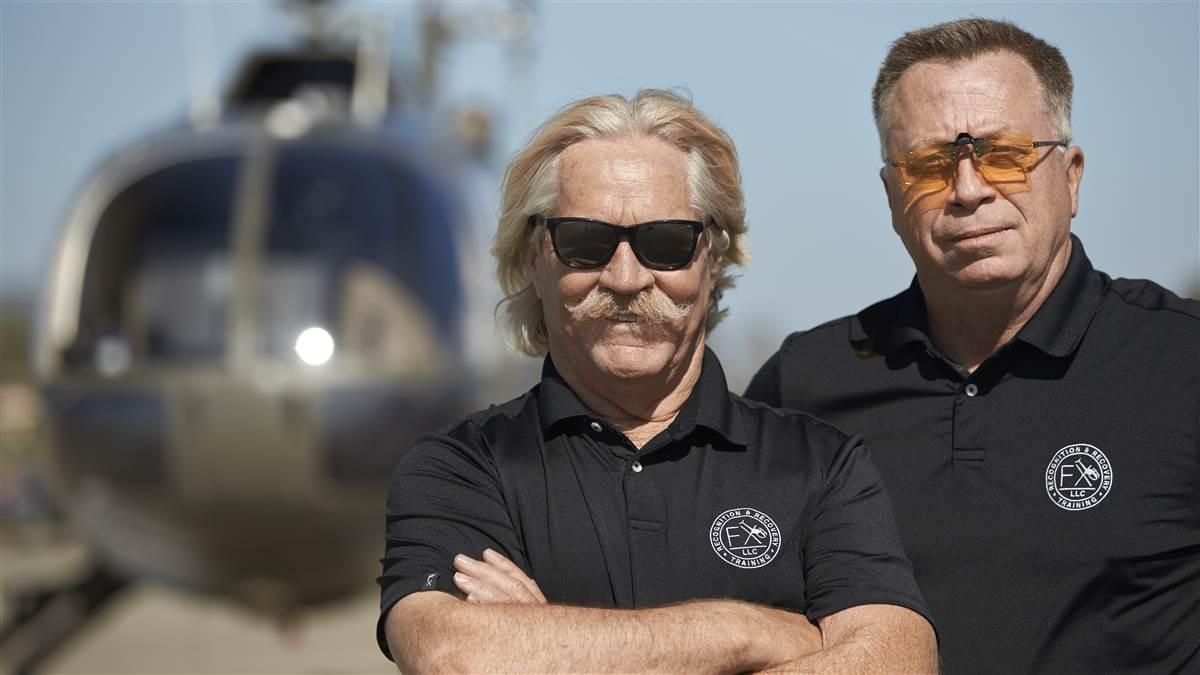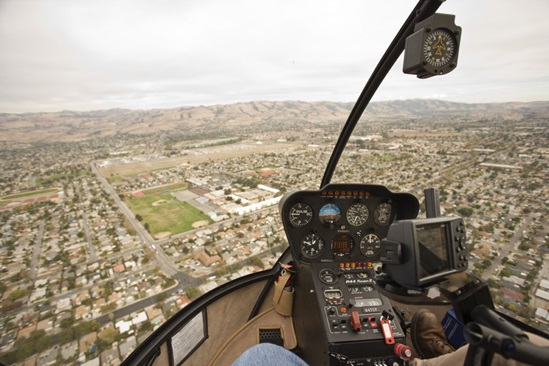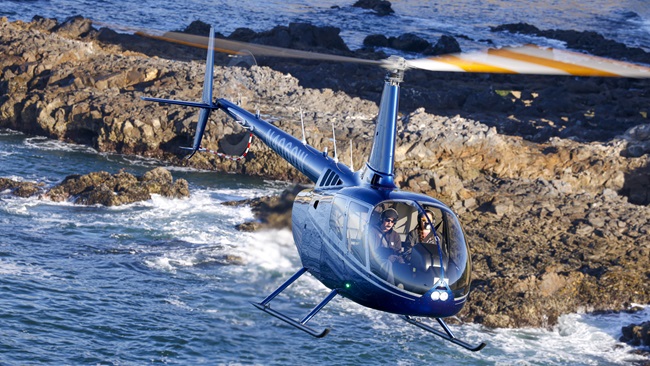Recover and reverse

A white paper issued jointly by the Helicopter Association International, the General Aviation Manufacturers Association, the American Helicopter Society International, and the Aircraft Electronics Association in June 2015 indicates the seriousness of the loss-of-control problem in the rotorcraft industry. Between 2001 and 2013 there were 248 helicopter accidents resulting from inadvertent entry into instrument meteorological conditions (IMC) and controlled flight into terrain (CFIT) while attempting to avoid weather at low altitude. The majority of these were fatal—truly alarming statistics, considering the relatively small population of helicopters.
Helicopters are at much greater risk of inadvertent entry into IMC, and departure from controlled flight, because they fly so low (typically 200 to 500 feet agl) and in visibility much less than is allowed for fixed-wing pilots. The aircraft often fly at night and frequently over inhospitable terrain. This is especially true for first responders—those who fly helicopters for law enforcement agencies, fire departments, and emergency medical services.
 Not reflected in the accident data are the near misses of obstacles and terrain that occurred while attempting to avoid weather, or the near losses of control that occurred while attempting to exit IMC.
Not reflected in the accident data are the near misses of obstacles and terrain that occurred while attempting to avoid weather, or the near losses of control that occurred while attempting to exit IMC.
Although half of the pilots involved in the accidents cited in the white paper were instrument rated, they were almost as susceptible to upset as those without instrument training. This is because helicopter pilots seldom fly IFR and typically do not maintain instrument currency to anywhere near the level that fixed-wing pilots do. And maintaining instrument skills by flying a helicopter under a hood is impractical because the pilot sits in a large glass bubble, and a conventional hood is ineffective in preventing him from seeing outside. Furthermore, many small helicopters are not certificated for IFR flight. It is not surprising, therefore, that loss-of-control accidents account for more helicopter fatalities than any other cause.
Inadvertent entry into IMC at such low altitudes can be a shock to the psyche, and recovery leaves little room for error. Even those with instrument training and experience seldom transition to instruments (when available) to escape IMC, because they are so close to the ground. Helicopter pilots do everything possible to remain in visual conditions. Unfortunately, they are not always successful. During the study of such accidents, it was discovered that the time from an inadvertent IMC encounter to impact varies from 45 seconds to 2.5 minutes.
These accident statistics prompted Anthony Burson, chief pilot for United Technologies’ flight department and recent Helicopter Association International board chairman, to ask Chuck Aaron to develop a program that would make effective upset-and-recovery training available for helicopter pilots. Aaron was chosen because of his worldwide name recognition, industry respect, and expertise in upset recovery. He was, after all, the first pilot ever authorized by the FAA to perform low-altitude helicopter aerobatics at airshows. Under the sponsorship of Red Bull, he conducted more than 250 public aerobatic exhibitions. He also was first to certify a helicopter for aerobatics and has been an on-screen motion-picture pilot performing mind-boggling stunts (such as in the opening scenes of the 2015 James Bond film Spectre). Burson believed that Aaron would be the ideal person to help call attention to the hazards associated with loss-of-control accidents in helicopters and possibly develop solutions.

Aaron was keenly aware of the problem, accepted the challenge, and founded FX-LLC, his new training facility at the Camarillo Airport in Southern California (approximately 50 miles west of Los Angeles). The company is devoted to upset-and-recovery training in helicopters. He then partnered with Kevin L. Bredenbeck, who also knows a thing or two about doing unusual things in helicopters. Bredenbeck is one of the nation’s foremost helicopter test pilots (civil and military). He conducted numerous first flights in several prototype helicopters, including the Sikorsky X–2 Technology Demonstrator, the S–97 Raider, and the UH–60M. He also holds several official and unofficial rotorcraft speed records. Bredenbeck is a recipient of the prestigious Collier Trophy as well as the Iven C. Kincheloe Award, the highest honor bestowed by the Society of Experimental Test Pilots.
 Aaron and Bredenbeck developed a comprehensive syllabus that goes far beyond available simulator training and its inherent limitations. The creative, effective program closely parallels those available for fixed-wing pilots.
Aaron and Bredenbeck developed a comprehensive syllabus that goes far beyond available simulator training and its inherent limitations. The creative, effective program closely parallels those available for fixed-wing pilots.
The upset-and-recovery course takes two to three days, depending on weather, and includes five hours of specialized ground school training, 3.5 hours in the company’s Messerschmitt-Bölkow-Blohm BO–105 twin-turbine helicopter, and four hours devoted to briefings and debriefings. The German BO–105 is well suited for this kind of flying because of its rigid rotor configuration.
The original program included some simulator training, but this proved ineffective and made students ill. (All of them were professional pilots.) Aaron says the only time he has ever been airsick was in a helicopter simulator. “Besides,” he says, “using an actual helicopter for teaching upset and recovery is so much more realistic.”
The course is planned around various mission scenarios and flight profiles. Bredenbeck adds that “students learn safe and rapid recovery from extreme situations, some of which can be rather intense.”
During the first flight, for example, an instructor will ask his student to reach up and deploy a specially designed black curtain that quickly prevents him from seeing outside the aircraft. During these few seconds of distraction, the instructor places the helicopter in a precarious upset attitude. The idea is for the pilot to feel what it is like to rapidly lose control. He is then taught the discipline needed to concentrate on flying the aircraft so as to recover and reverse course safely.
Aaron and Bredenbeck also have developed several instrument and visual procedures not taught elsewhere. An example is the procedure for making a quick turnaround in limited space, such as when flying low in a narrow canyon. It involves pulling the nose up about 20 degrees and allowing airspeed to bleed rapidly to zero. The nose is then lowered and hover power is applied in a timely manner (to prevent settling with power). Instead of applying left-pedal pressure to arrest the resultant right yaw, the torque of the main rotor is allowed to yaw the helicopter into a 180-degree right turn, at which point forward speed is restored to escape the area. This can be a challenging maneuver on instruments. (The turn is executed to the left in French and Russian helicopters, because their main rotors turn in the “wrong” direction.)
Inadvertent entry into IMC at such low altitudes can be a shock to the psyche, and recovery leaves little room for error.FX-LLC teaches the concept of executing instrument letdowns to previously selected open fields called emergency letdown points. These are essentially informal IFR approaches to waypoints stored by the pilot in the helicopter’s GPS. Also taught are instrument autorotations down to 100 feet above the field.
Most of FX-LLC’s clients consist of medevac, fire, and law-enforcement pilots with some corporate pilots thrown in for good measure. The program has been receiving unanimous praise.
Several insurance companies have approved FX-LLC’s upset-and-recovery program to satisfy their requirements for recurrent training and some offer premium discounts.
This is Barry Schiff’s 1,800th magazine contribution.



